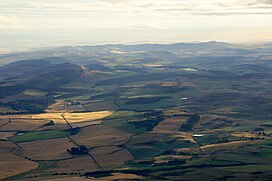| Sidlaws | |
|---|---|
 Aerial view of the Sidlaw Hills | |
| Highest point | |
| Elevation | 455 m (1,493 ft) |
| Coordinates | 56°30′N 3°10′W / 56.500°N 3.167°W |
| Geography | |
The Sidlaws are a range of hills in the counties of Perthshire and Angus in Scotland that extend for 30 miles (45 km) from Kinnoull Hill, near Perth, northeast to Forfar.[1] A continuation of the Ochils, they separate Strathmore to the north from the Carse of Gowrie on the shore of the Tay.[2]
At 1492 feet (455 metres), Craigowl Hill, north of Dundee, is the highest of the Sidlaws. Points of interest include Dunsinane Hill, mentioned in Shakespeare's play Macbeth, and Auchterhouse Hill, which was the site of an ancient hill fort. The ruined observatory on Kinpurnie Hill was built in the 18th century and can be seen for many miles on the Strathmore side of the Sidlaws. There is a local legend that a poacher named Brandon Henderson lived as a hermit in the tower for seven years in order to win a £100 bet.[3]
Sidlaw Hills is also the name of a "Schottische" marching tune composed for the fiddle by Jim Watson[4] of Blairgowrie (1868–1931).
- ^ United Kingdom Ordnance Survey Map, Landranger (2005)
- ^ "Sidlaw Hills". The Gazetteer for Scotland. Retrieved 30 March 2021.
- ^ Nelson, Douglas. "Kinpurnie Tower (C) Douglas Nelson :: Geograph Britain and Ireland". Retrieved 15 July 2014.
- ^ Tom Hughes and His Border Fiddle Archived 28 February 2007 at the Wayback Machine


